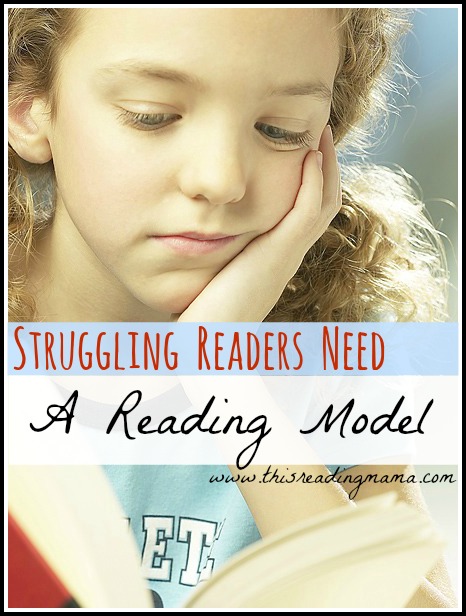Welcome to This Reading Mama! This is part 6 of a 10 week series on struggling readers. Click HERE or on the image above to read what I’ve posted about so far. Today, I’d like to continue my series on struggling readers and the point that struggling readers need a reading model.
*This post contains affiliate links. To learn more about this, please read my disclosure policy.
Parents as Reading Models
While it is certainly true that teachers make awesome reading models, I want to encourage you…mamas and dads make some of the best reading models as well! I want to first bust a myth many parents have. YOU DO NOT NEED TO BE A PERFECT READING MODEL!
Kids don’t need a perfect reading model. They need to see that we, too, at times struggle with reading. e might misread a word or lose track of our thought process and forget what we’ve read. We might even come across a word we’ve never seen before or a word of which we don’t know the meaning. What struggling readers need to see is what we do in response to these things happening. This empowers the struggling reader with strategies for when this happens to him.
Want more good news about being a reading model? You don’t have to have a teaching degree to be one! You probably already do many of these things automatically. The difference is that you become more aware of the things you’re already doing and point those out to your child as you read together.

Things to Model as You’re Reading
1. Read with Fluency
As you’re reading out loud, point out to your child that you sound like you’re talking versus reading-each-word-separately-in-a-disconnected-way.
- When you read that word in italics, say, “Did you hear how I emphasized that word more than the others in that sentence? That’s why the author wrote it like that. It’s called italics.”
- When you see that comma, say, “Did you hear how I paused a little bit when I got to the comma?”
- Say things like, “Did you notice how I made my voice sound like the cat when I read what the cat said? You can do that, too. Try it.”
2. Read for Different Purposes
Struggling readers need to see that you read different kinds of texts for different purposes. For example, you don’t pick up the magazine article about parenting and read for the same purpose as the latest book in your favorite fiction series. And because we read for different purposes, we don’t always read everything the same way. Here are some ways to phrase this:
- “I’m searching online to find out more about this particular type of plant. I’m going to skim all of the other information until I find what I’m looking for.”
- “I am reading this book just for enjoyment. Sometimes, it’s just nice to veg out and relax with a book.”
- “I want to find out who won the basketball game. So, I don’t need the entire newspaper…just the sports section.”
- “That poem made me laugh. I love how the author has such a sense of humor!”
3. Model Your Thinking (Comprehension) as You Read
Many of the struggling readers I’ve encountered think that good readers are people who can say all the words correctly. While automatic word recognition is very important, it is only a part of reading. We also THINK as we read. I want to focus on two areas to demonstrate how we think as we read- a. “fix it” strategies and b. comprehension strategies.
“Fix Up” Strategies
Have you ever misread a word and the sentence didn’t make any sense? Ever lost your train of thought and had to re-read an entire paragraph over again because you couldn’t remember what it said? Sure. We’ve all done that. Struggling readers need to see that we get confused at times. They need to hear us say, “That didn’t make sense.” or “Wait! I have no clue what the author was just trying to say.” But more importantly, they need to see you model what you do when this happens; such as re-reading or doing some research to build your knowledge about a particular subject so you can understand the content. You can read more about these “fix up” strategies as well as download a FREE resource here.
Comprehension Strategies
I’ll give you three simple ways to model comprehension, but you can read about each one in our Reading Comprehension Strategies series.
- Making pictures in your head: Maybe the author describes a scene or a what a person looks like. Take the time to share your mental image. What does that person look like to you? What does the scene look like? And you’ll find that your picture and your child’s picture won’t always be the same…that’s the way it’s supposed to be!
- Predicting: Tell your child what you think will happen next and WHY. What makes you think that will happen next? What clues does the author leave? If you were that character, what would you do? And remember, predictions don’t need to always be correct. Model a “wrong” prediction and let your child see that although your prediction was a good one, it wasn’t what happened and that’s OK!
- Inferring: This is when you can “read between the lines” and guess something about the text, even when the author doesn’t come right out and s-p-e-l-l it out for you. If the text says, “The snow fell all day and all night,” model by saying, “I can infer (or guess) that it’s wintertime. The author didn’t tell me, but it would make sense that if snow was falling, it was probably winter.” Or if it says of a character, “She stomped her feet out of the room and slammed the door,” you can say, “Even though the author didn’t say that she is mad, I am inferring that she is angry because happy people don’t usually stomp their feet and slam doors.”
- If you’re ready to bite off more on modeling comprehension, check out these resources:
- Reading Comprehension Strategies {10-week series with lessons and hands-on printables}
- Comprehension Strategies: Reading Equals Thinking
- Books for Teaching Comprehension
- 50+ Books for Modeling Comprehension Strategies
- 5 Simple Ways to Improve Reading Comprehension
- Comprehension Pinterest Board
I hope that from these examples, you can see clearly that being a reading model isn’t rocket science. It’s letting your child hear the thoughts that are already going on inside your head as you read. And I hope you can feel at peace that struggling readers don’t need a perfect model. As a matter of fact, being perfect doesn’t leave much room (if any) for teaching at all! As a reading model, you and I just need to be more aware of the strategies we already use as a reader and share those with our struggling readers.
~Becky

Leave a Reply